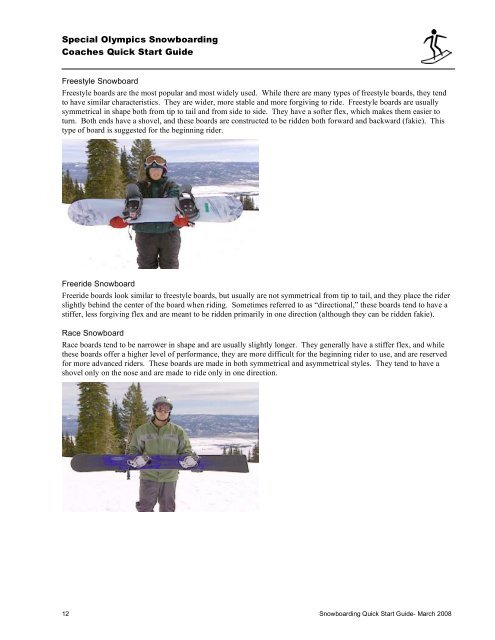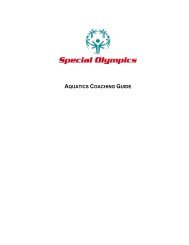N O W B O A R D IN G - Special Olympics
N O W B O A R D IN G - Special Olympics
N O W B O A R D IN G - Special Olympics
You also want an ePaper? Increase the reach of your titles
YUMPU automatically turns print PDFs into web optimized ePapers that Google loves.
<strong>Special</strong> <strong>Olympics</strong> Snowboarding<br />
Coaches Quick Start Guide<br />
Freestyle Snowboard<br />
Freestyle boards are the most popular and most widely used. While there are many types of freestyle boards, they tend<br />
to have similar characteristics. They are wider, more stable and more forgiving to ride. Freestyle boards are usually<br />
symmetrical in shape both from tip to tail and from side to side. They have a softer flex, which makes them easier to<br />
turn. Both ends have a shovel, and these boards are constructed to be ridden both forward and backward (fakie). This<br />
type of board is suggested for the beginning rider.<br />
Freeride Snowboard<br />
Freeride boards look similar to freestyle boards, but usually are not symmetrical from tip to tail, and they place the rider<br />
slightly behind the center of the board when riding. Sometimes referred to as “directional,” these boards tend to have a<br />
stiffer, less forgiving flex and are meant to be ridden primarily in one direction (although they can be ridden fakie).<br />
Race Snowboard<br />
Race boards tend to be narrower in shape and are usually slightly longer. They generally have a stiffer flex, and while<br />
these boards offer a higher level of performance, they are more difficult for the beginning rider to use, and are reserved<br />
for more advanced riders. These boards are made in both symmetrical and asymmetrical styles. They tend to have a<br />
shovel only on the nose and are made to ride only in one direction.<br />
12 Snowboarding Quick Start Guide- March 2008

















